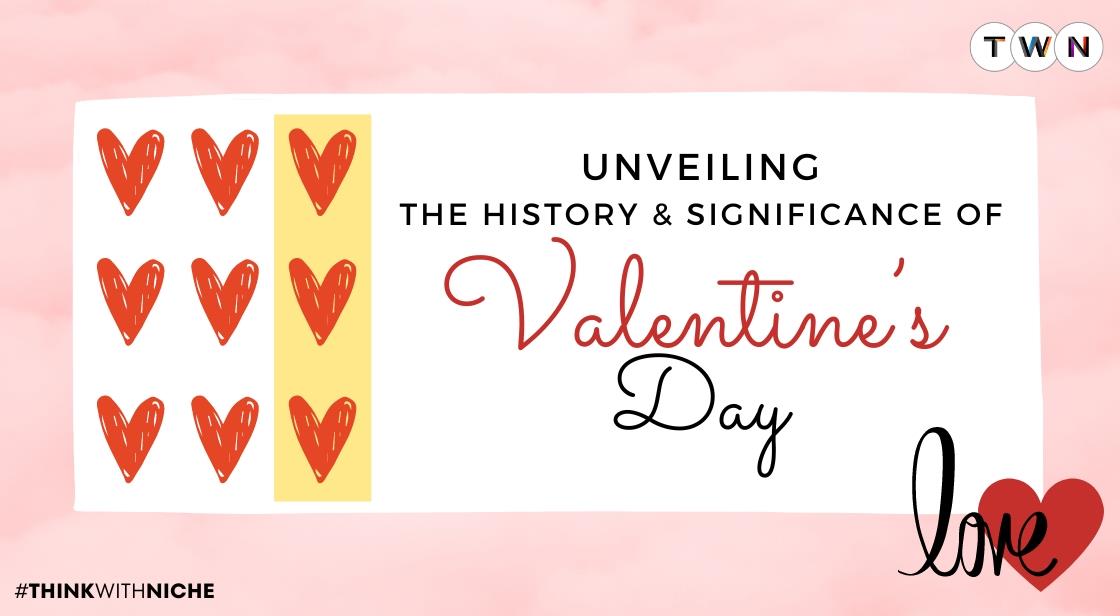Unveiling the History and Significance of Valentine's Day

Blog Post
Forget the overpriced chocolate and saccharine greetings; Valentine's Day boasts a surprisingly intricate history, weaving together threads of ancient Roman festivals, Christian saints, and ever-evolving cultural interpretations.
While February 14th has morphed into a global celebration of romantic love, its journey began far from Hallmark decorations and commercial frenzy. Delve with us into the rich tapestry of this beloved holiday, uncovering its fascinating origins and diverse interpretations across the world.
Did you know Valentine's Day might have roots in fertility rituals of ancient Rome?
Or that its association with romantic love was championed by a medieval poet?
Explore the intriguing possibilities as we embark on a historical voyage, unmasking the enigmatic Saint Valentine and his potential connection to this day of love.
We'll then witness the transformation of Valentine's Day from a religious observance into a celebration of affection through love notes, Victorian-era sentimentalism, and the iconic invention of mass-produced cards.
But beyond the symbols of hearts, roses, and chocolates, lies a deeper significance. We'll delve into the diverse meanings Valentine's Day holds across cultures, from celebrating romantic love to cherishing familial bonds and embracing self-love.
As societal values and norms continue to evolve, so too do interpretations of this day, with some questioning its commercialization and advocating for more inclusive expressions of love.
So, whether you embrace Valentine's Day wholeheartedly or roll your eyes at the consumerism, understanding its complex past and present enriches your appreciation for its multifaceted nature.
Join us on this journey to discover the true meaning of love, be it romantic, familial, or a celebration of oneself, on this beloved holiday and beyond.
Unveiling the Origins of Valentine's Day: A Journey Through Time
Valentine's Day, a cherished celebration of love observed annually on February 14th, has a captivating origin rooted in ancient traditions. This romantic day found its place in the calendar through the convergence of historical events and cultural practices.
The Ancient Roman Connection:
Valentine's Day's journey commences with the ancient Roman festival called Lupercalia. Taking place in mid-February, Lupercalia was dedicated to fertility and the arrival of spring. Within this festival, a distinctive ritual unfolded, potentially influencing the romantic essence of Valentine's Day. Men and women participated in a unique pairing ceremony, selecting names from a jar that determined their companionship.
Love in Ancient Greece:
Venturing further back, Ancient Greece also contributed to the foundation of mid-winter celebrations associated with love. The Greeks observed a special festival marking the marriage of Zeus, the king of gods, and Hera, the queen of gods. This mid-winter celebration reflected the divine union of these powerful deities, symbolizing love and matrimony.
Chaucer's Influence on Valentine's Day:
The romantic connotations of Valentine's Day gained momentum in the 14th century, thanks to the poetic prowess of Geoffrey Chaucer. The English poet linked this day to the romantic realm through his literary works. Chaucer's influence played a pivotal role in transforming Valentine's Day into a celebration of love and affection.
Christianity and Saint Valentine:
As Christianity spread its influence, the celebration acquired a saintly touch. Saint Valentine, a priest in ancient Rome, became a symbol of love and compassion. Although the details of his life remain somewhat enigmatic, he is associated with acts of kindness and love, contributing to the amalgamation of Christian values with the romantic spirit of Valentine's Day.
Unraveling the Enigma of Saint Valentine: Legends and Legacy
Saint Valentine, a mysterious figure in history, has left an indelible mark on the cultural tapestry of love, evolving into the patron saint of affection and devotion. While the true identity of Saint Valentine remains shrouded in ambiguity, various legends contribute to the captivating narrative surrounding this enigmatic figure.
Feast Day in Catholic Tradition:
St. Valentine's Day found its roots as a feast day in the Catholic religion, officially added to the liturgical calendar around 500 AD. This day was designated to honor martyred saints named Valentine, yet historical records provide limited insights into these revered individuals. Differing legends highlight three distinct saints named Valentine or Valentinus, contributing to the mystique surrounding the feast day.
Legends of Saint Valentine:
The legends of Saint Valentine are as diverse as they are intriguing. One account narrates the story of a Valentine who defied conversion to paganism and faced execution under Roman Emperor Claudius II. Miraculously, he healed the jailer's daughter before his demise, leading to the conversion of the jailer and his family to Christianity.
Another legend introduces a bishop named Saint Valentine of Terni, suggesting him as the true namesake of the holiday, also meeting a tragic end. However, the legend that intertwines Saint Valentine with the theme of love is the tale of a Roman priest.
This priest performed weddings for soldiers, contravening an edict by a Roman emperor that forbade marriage for soldiers, asserting that married soldiers were not formidable warriors. To aid in his clandestine endeavors, this Saint Valentine wore a ring adorned with a Cupid, a symbol of love, enabling soldiers to recognize him. As a precursor to modern greeting cards, he distributed paper hearts to remind Christians of their love for God.
Patron Saint of Love:
Saint Valentine emerged as the patron saint of love due to the aforementioned legend involving the Roman priest defying the emperor's decree. The Saint Valentine prayer echoes the desire for lovers to be united, emphasizing the sanctity of their connection and their devotion to God.
Chaucer's Influence and the Modern Celebration:
The connection between Saint Valentine and romantic love was further solidified by Geoffrey Chaucer, a medieval author, in his 1375 poem. This work is considered the origin of the "modern" celebration of Valentine's Day, where individuals express their romantic sentiments toward a significant other.
In essence, Saint Valentine, with his veiled history and multifaceted legends, stands as a symbolic figure associated with love, devotion, and the timeless celebration of affection.
Modern Global Celebration of Valentine's Day:
Fast forward to the 19th century, and Valentine's Day underwent a significant transformation. Mass production of Valentine's Day cards began, and the image of Cupid, the mischievous god of love, became an iconic symbol. Commercialization took hold, turning the celebration into a global phenomenon marked by the exchange of cards, gifts, and romantic gestures.
1. Digital Age and Love Expressions:
In the contemporary era, Valentine's Day has adapted to the digital landscape. Social media platforms, virtual greetings, and online expressions of love have become integral parts of the celebration, connecting individuals across the globe.
Valentine's Day, celebrated on February 14th each year, has become synonymous with romantic love, chocolates, and red roses. But beyond the Hallmark decorations and commercial frenzy lies a fascinating history intertwined with ancient Roman festivals, Christian saints, and evolving cultural interpretations. Let's delve into the rich tapestry of this beloved holiday.
2. From Saints to Sweethearts:
The transition from religious observance to romantic celebration was gradual. In the 14th and 15th centuries, Valentine's Day became associated with exchanging love notes and tokens of affection. Victorian-era sentimentalism further cemented its romantic character, with the invention of mass-produced Valentine's cards in the 19th century solidifying its commercial appeal.
3. Symbols and Traditions Take Root:
Over time, a distinct visual and cultural vocabulary emerged:
-
The Heart: A universal symbol of love, rooted in ancient beliefs about the heart being the seat of emotions.
-
Roses: Representing passion and love, with different colors conveying specific messages.
-
Chocolates: Associated with indulgence and pleasure, becoming a popular Valentine's Day treat since the 19th century.
-
Lovebirds: Symbolizing loyalty, affection, and everlasting love.
-
Gift-giving: From flowers and chocolates to personalized mementos, expressing love through gifts remains a cherished tradition.
-
Romantic Dinners: Creating a special ambiance and enjoying a shared meal has become a popular way to celebrate.
-
Love Notes: Whether handwritten or digital, expressing feelings through messages remains a timeless tradition.
Different days associated with the Valentine's Day
While the main focus remains on February 14th, Valentine's Day itself, there are several other days associated with it, often forming a week-long celebration of love and affection. These days each have their own unique theme and focus, offering different ways to express love and appreciation. Here's a breakdown of some popular ones:
1. Rose Day (February 7th):
-
Marks the beginning of Valentine's week.
-
Traditionally, red roses are gifted to express romantic love and passion.
-
Other rose colors can symbolize different emotions like friendship, appreciation, or new beginnings.
2. Propose Day (February 8th):
-
Considered a day to express deeper commitment and intentions.
-
Traditionally, individuals use this day to propose marriage, confess their love, or initiate serious relationships.
-
Can also be used to express a desire for commitment in existing relationships.
3. Chocolate Day (February 9th):
-
Indulging in sweet treats to express affection and care.
-
Chocolates symbolize sweetness, happiness, and pleasure.
-
Gifting chocolates can be a way to show appreciation for friends, family, or romantic partners.
4. Teddy Day (February 10th):
-
Gifting teddy bears as symbols of comfort, love, and protection.
-
Traditionally associated with romantic gestures, but can also express platonic affection or childhood memories.
-
Stuffed animals of other kinds can also be gifted on this day.
5. Promise Day (February 11th):
-
Making promises and strengthening bonds of love and commitment.
-
Couples often exchange promises of loyalty, trust, and lasting love on this day.
-
Promises can also be made to oneself or loved ones for personal growth and improvement.
6. Hug Day (February 12th):
-
Celebrating the warmth and comfort of physical touch.
-
Hugging releases oxytocin, a hormone that promotes bonding and feelings of love.
-
Can be a way to express affection with friends, family, or romantic partners.
7. Kiss Day (February 13th):
-
Celebrates intimacy and the emotional connection conveyed through a kiss.
-
Can range from friendly pecks to passionate embraces, depending on the relationship.
-
Symbolises affection, love, and deeper emotional connection.
8. Valentine's Day (February 14th):
-
The culminating day of celebration, dedicated to love in all its forms.
-
Traditionally associated with romantic gestures like exchanging gifts, going on dates, or expressing love through cards and messages.
-
Can also be celebrated with friends and family as a day of love and appreciation.
Remember, these are just some of the popular days associated with Valentine's Day. Different cultures and communities may have their own traditions and ways of celebrating love throughout the week or even the month. Ultimately, the most important aspect is to find ways to express and celebrate love in meaningful ways that resonate with you and your loved ones.
A Global Celebration with Nuances:
While often associated with romantic love, Valentine's Day holds diverse meanings across cultures:
-
Global Reach: Celebrated in countries worldwide, Valentine's Day has become a significant commercial event.
-
Beyond Romance: In some cultures, the day extends to expressing love for family, friends, and oneself, promoting broader social connections.
-
Evolving Interpretations: As societal values and norms change, interpretations of Valentine's Day continue to evolve, with some questioning its commercialization and advocating for more inclusive expressions of love.
Conclusion:
Valentine's Day, with its complex history and evolving interpretations, offers more than just heart-shaped candies and overpriced roses. Understanding its journey enriches our appreciation for this multifaceted holiday, allowing us to celebrate love in its diverse forms, be it romantic, familial, or self-love. Ultimately, Valentine's Day reminds us of the importance of connecting with loved ones and expressing our emotions, enriching our lives with the warmth.
You May Like
EDITOR’S CHOICE












